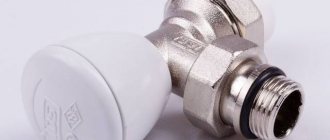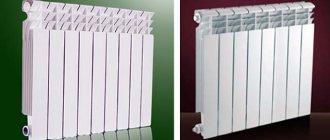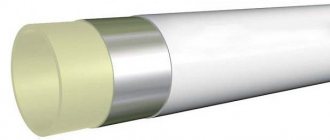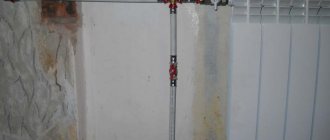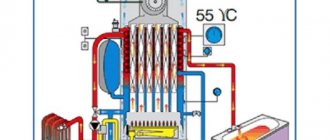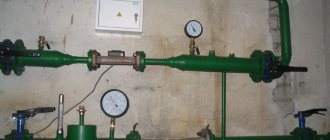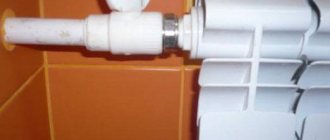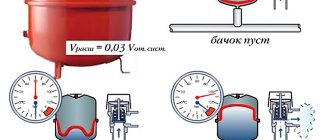Bypass device
A bypass is a bypass part of the pipeline that ensures the coolant moves along a path that bypasses a certain section of the pipeline. One edge of the circuit is connected to the supply pipe, and the second to the return pipe. Various elements of the heating system, such as pumps, are usually installed on the bypass.
At the connection point between the bypass and the inlet pipe of the device that needs to be bypassed, a shut-off valve is installed. Its presence makes it possible to direct the flow of liquid parallel to the device itself and regulate the intensity of the coolant supply. A valve is also installed on the return pipe, which allows you to exclude a section of the pipeline from the system without the need to stop it.
How is a bypass installed in a heating system?
Installation of the bypass circuit can be carried out according to different schemes:
- On radiators of single-pipe systems of open or closed type.
- Parallel to a pumping device that operates in a gravitational heating network (gravity system).
- Installation as a jumper between the supply and return pipes of the coolant.
- Installation on mixing units.
If we are talking about a high-rise building, where a heated towel rail is connected to the main hot water riser, a bypass must also be installed .
Types of bypasses for heating
When installing a bypass, shut-off valves are installed not only on the pipes of the connected device, but also on the bypass itself. The type of fittings used allows us to classify several types of bypasses, each of which is suitable for certain operating conditions.
The following types of bypasses exist:
- Unregulated;
- With manual control;
- Automatic.
The characteristics of devices with different types of shut-off valves have significant differences, so before installing a bypass in the heating system, you need to carefully consider each type.
Unregulated bypass
The device of unregulated bypasses is a simple pipe that does not have any equipment. The pipe is constantly in an open state, and the liquid moves through it arbitrarily, that is, there is no opportunity to influence the intensity of the water flow. Unregulated bypass pipes are most often used to connect heating appliances.
When designing a heating system, it is necessary to take into account the fact that water always moves primarily through those areas where the hydraulic resistance is minimal. In the case of a bypass, this means that the internal diameter of its vertical section must be smaller than the internal cross-section of the main pipeline. If this requirement is not met, the coolant will simply gravitate towards the bypass.
When designing horizontal heating distribution, other rules apply that must be taken into account before making a bypass into the heating system. The heated coolant has a reduced specific gravity and always tries to move upward. In order for the system to operate normally taking into account this rule, the diameter of the lower part of the bypass must match the diameter of the main line, and the cross-section of the pipe leading to the radiator must be smaller.
Bypasses with manual adjustment
Bypasses that are adjusted manually (manual bypasses) are equipped with ball valves. The use of ball valves is determined by the fact that they do not change the pipeline capacity at all when switching, since the hydraulic resistance in the system does not change. This quality makes the ball valve an optimal option for bypass.
Shut-off valves of this type allow you to regulate the volume of liquid that passes through the bypass section. When the tap is closed, the coolant moves in full along the main line. The operation of ball valves has one important nuance - they need to be turned regularly, even if there is no need to adjust the system. This is due to the fact that if left stagnant for a long time, the taps may become tightly stuck and will have to be replaced. Sometimes a heating system feed valve is also installed, which plays a significant role.
Manual bypasses in heating systems can be used in several ways. Most often they are used to connect batteries to a single-pipe main, as well as for piping circulation pumps.
Automatic bypasses
Bypasses with automatic adjustment are usually installed in the piping of a pump installed in a system with natural coolant circulation. Such heating systems can operate independently, but thanks to the pump, the speed of fluid movement along the circuit increases, which reduces heat losses and increases heating efficiency.
The presence of an automatic bypass in the pump piping allows the system to independently regulate its operation, i.e. no human intervention required. When the pump is running, the coolant passes through it, and the bypass is closed at this time. When the pump stops, the bypass opens and the liquid moves in it, while the stationary pump impeller cuts off the coolant flow.
Automatic bypasses are divided into two types:
- Valve;
- Injection.
The design of the first type of device contains a check ball valve. The hydraulic resistance of the valve is minimal, so the liquid easily moves on its own. When the pump is turned on, the coolant begins to move faster, is transported into the main line and diverges in two directions.
Further movement of the liquid occurs without any obstacles, and the reverse flow is blocked by the valve. The operating principle of the valve itself is extremely simple - the hydraulic pressure on the outlet side exceeds the inlet pressure, so the ball is pressed closely against the seat of the structure and does not allow the fluid to move.
Valve bypasses are quite convenient and simple, but they are very demanding on the quality of the water with which the heating system is filled. If the water contains various impurities, such as rust or scale, the valve very quickly becomes dirty and becomes unusable, as a result of which it has to be replaced.
Injection bypasses are devices similar in principle to a hydraulic elevator. A pumping unit is installed in the main line, which is connected to the main circuit using pipes of smaller diameter. With this scheme, both pipes are inserted into the main pipeline.
When the pump starts, part of the liquid enters the nozzle and is passed through the apparatus, accelerating many times in the process. The outlet pipe, which is slightly narrowed and visually resembles a nozzle, which ensures efficient pumping of liquid, also works to increase speed.
A vacuum is created behind the outlet pipe, due to which the coolant begins to be sucked out of the bypass. The flow, moving under pressure, pulls all the liquid with it, and it continues to move along the main highway with noticeable acceleration. This effect allows you to completely prevent the possibility of reverse flow of liquid.
The technology described above only works when the pump is turned on. If the pumping equipment is turned off, then the coolant in full passes through the bypass under the influence of gravitational forces.
What is bypass in heating systems
A bypass is a section of the pipeline that acts as a jumper and is mounted between the forward and return pipes in order to control the uninterrupted supply of liquid.
The bypass circuit is made of the same material from which the riser is made, but a pipe of smaller diameter is chosen for this. Optionally, a check valve is installed on the “shunt” to prevent the outflow of liquid against the main circulation.
Bypass purpose
The main function of any bypass is the ability to keep the heating system in working order even if one of its elements breaks down or there is a power outage. Devices connected via bypass can be disconnected from the system without any problems - to do this, you just need to turn off both taps, and the coolant will flow around the circuit.
Thanks to the bypass, heating can continue to operate in any case, and damaged elements can be repaired, spending any amount of time. The reliability and ease of maintenance of the heating system with a bypass increases many times over.
In autonomous heating circuits, the bypass is used to solve the following problems:
- Connecting heating devices to single-pipe wiring;
- Pumping equipment piping;
- Connecting the water heated floor distribution manifold;
- Formation of a small circulation circuit when using solid fuel heating equipment.
The bypass installation method may vary depending on its purpose in a particular heating system.
Bypass and circulation pump
Autonomous heating is the optimal solution for a country house. The system is often equipped with a pump that provides forced supply of coolant, which improves its operating efficiency. The pump consumes electricity, but the installation is economically justified by increased heat transfer.
The disadvantage of the pump is its dependence on the power source. In the absence of electricity, the unit stops working, and communication efficiency decreases. To prevent problems from occurring, experts recommend using bypasses for the circulation pump.
In this case, the pump is connected to the system via a bypass. In other words, it is installed on the jumper itself. Valves are installed on both sides. At the same time, a tap is installed on the main line between the inlet and outlet of the jumper. In normal mode, water flows through the bypass. If there is a loss of electricity, then the taps on it are closed, and on the main line they are opened. The coolant is redirected directly bypassing the bypass.
Taps are installed on the jumper with the pump
Bypass for radiator
In single-pipe heating systems, batteries are best connected using a bypass. For two-pipe circuits and manifold distributions, bypasses are not needed, since all heating devices are connected in parallel, and each of them receives coolant at the same temperature. If one of the batteries fails, it can always be removed without turning off the heating system (of course, if there are shut-off valves).
In systems with single-pipe wiring, the batteries are connected in series, so the coolant in each subsequent device cools down. The result is obvious - distant devices receive much less heat, and there can be no talk of any uniform distribution of thermal energy.
Bypasses can solve the problem. The supply and return circuits are connected by a jumper, which ensures independent flow movement. The hot coolant enters directly into the radiator, while the other part of it passes further and at the outlet is mixed with cooled water from one radiator. This scheme allows you to deliver much more heat to subsequent heating devices.
Bypass for a radiator in a single-pipe heating line
Installing a bypass in the heating system in parallel to the battery allows you to regulate the flow of liquid through it and, accordingly, the temperature regime, and also provides the ability to replace or repair a heating device without stopping the functioning of the heating, which is especially important in apartment buildings. How to install the bypass correctly?
Let's look at the picture, similar systems look something like this...
The bypass photo of which you see on the left is just an ordinary jumper that connects the supply (hot) and return (cold) pipes directly next to the battery.
Ball valves are installed between the jumper and the radiator. They allow you to turn off a separate device, and the coolant will calmly circulate along a parallel bypass path.
The third tap can be installed on the jumper itself and allows you to adjust the bypass mode - the balance of fluid flow through the heating battery and the bypass pipe. The closed position of this valve ensures the circulation of the entire coolant flow through this heater. Optionally, instead of a tap on the supply pipe in front of the radiator, a thermostat can be installed to maintain the temperature in the radiator set on it.
In houses with central heating, it is advisable to install a bypass for the heated towel rail, since many models of this heating device may not be designed for the parameters of our boiler rooms. In this case, the bypass diameter is chosen smaller than the diameter of the main pipes - usually a half-inch pipe.
Why is bypass needed? It allows you to reduce energy costs by limiting the amount of coolant entering the radiator. Thus, the heat transfer from the heating battery is reduced and energy is saved. The lack of adjustment options simply leads to overheating of the room, followed by opening of the vents and evaporation of heat. The heat exchanger with bypass used in boilers allows you to regulate the required coolant flow through it.
By installing a bypass yourself (if you have plumbing skills), you will leave a significant amount of money in your pocket.
Connecting the pump via bypass
It is advisable to connect the circulation pump via bypass only in those systems that were originally designed for natural circulation, i.e. they must have an accelerating manifold, pipe slopes must be observed and their diameters must be correctly selected. The pump in such systems is not intended to ensure their operation, but to increase efficiency.
For systems that were designed for forced circulation at the design stage, a bypass is simply irrelevant. Such systems operate only due to the pump, so when it is turned off, the circulation of the coolant simply stops. Bypass in this case will not solve the problem.
When connecting the pump via a bypass line, it becomes possible for counterflow in the bypass. In addition, a closed circulation loop is formed between the pump and the bypass itself. In order for such a circuit to function normally, the bypass device must be equipped with a ball valve or check valve.
When the pump is running, the device blocks the flow of liquid through the bypass pipe. The valve does this work automatically, but the tap has to be adjusted manually. When the pump stops, the bypass opens, which allows coolants from different circuits to mix. A similar scheme is not applicable in the case of injection bypasses - they completely eliminate the possibility of reverse coolant flow.
Examples of use (connection) of a bypass: option for a circulation pump, boiler, tap
Bypass in heating is designed to form an alternative flow bypassing the components of the heating main (circulation pumps, radiators and shut-off valves). In a multi-storey building, this device helps in repairing radiators during the heating season. By redirecting the flow of coolant around the battery, it is possible to replace or repair the structural part of the system. Bypass can be used in any main line. In addition, bypass is used in the following cases:
- Regulation of water heat transfer. The main purpose of the jumper is to overflow excess water from the radiator into the riser in cases where its volume changes due to changes in the thermostat. In other words, the coolant is transported through an additional line parallel to the fittings. If the heating is in use, it is impossible to repair the radiator without a bypass pipe. Another function is to stimulate faster emptying and filling of risers and radiators, even in cases where a manual control valve is not installed.
- Ensuring uninterrupted operation of the system during a temporary lack of electricity. A bypass line is necessary when installing heating using circulation pumps. Such equipment guarantees uninterrupted heating operation during a power outage. In conditions where there is no current in the network, it is necessary to close the taps for supplying media to the pump and immediately open the tap from the central pipe. In cases where a control valve is installed for heating, this process is carried out automatically. As a result, the system begins to operate in natural circulation mode.
- Improving the operation of single-pipe heating. This arrangement is typical of Soviet-built houses. It is recognized as obsolete, but in old apartments it can be unbearably hot in winter. To optimize the temperature regime in residential premises, experts recommend installing a bypass. After installing this device, residents will be able to independently regulate the supply of coolant.
Water from the boiler enters the pipeline through which it moves, sequentially bypassing all heating devices. Upon completion of its movement, it returns to the cauldron. Due to heat transfer through radiators, the temperature of the carrier fluid decreases. It is the heat given off due to the temperature difference at the outlet of the boiler and its inlet, taking into account the flow rate and heat capacity, that enters the room from the heating system.
You can reduce the amount of heat transferred by making the liquid move faster, bypassing the batteries. This is why they install the simplest bypass, supplying it with only one ball valve, which can be opened to different sizes.
- LiveJournal
- Blogger
Using a bypass, you can regulate the temperature in the room.
The less coolant that enters the heat-emitting heating device, the less heat will be released into the room. Accordingly, by closing the bypass valve, you can force the coolant to move completely through the devices. In this case, the heating system will release heat flow to the maximum.
Instead of a tap, it is allowed to install a check valve for heating in the bypass pipe. When the circulation pump is turned on, it remains closed, and when the current supply is turned off, it opens automatically. A heating check valve helps the system switch to natural circulation mode. It may begin to malfunction due to rust and other inclusions, especially if the pipes and radiators are made of steel and cast iron. You cannot place a filter in front of it, and the extension cord will have no effect. You can check for blockages only when disassembling the system. Therefore, installing a check valve with automatic inclusion in the bypass is considered controversial.
For heated floors
When installing a heated floor, it is imperative to install a mixing unit, in which a bypass pipeline is always built in. The bypass in this case will be used to ensure the normal operation of the heated floor, and without this element the heating will not be able to function.
It's all about the operating temperature, which must be maintained in heated floors. The coolant in the supply circuit can heat up to 80 degrees, but in a heated floor its temperature should not exceed 45 degrees. The liquid is brought to the required temperature in a mixing unit, which passes only the required volume of hot water. The entire remaining flow is directed to the bypass, where it is connected to the coolant from the return circuit, and returns to the boiler.
For systems with solid fuel boiler
When used in combination with solid fuel heating equipment, the bypass allows the formation of a small circulation circuit. To do this, the bypass pipe is installed in the supply, where there is a coolant heated to the limit, and is connected to a three-way valve located on the opposite side of the structure.
Thanks to the valve, hot water from the bypass and cold water coming from the return circuit are mixed. As a result, a coolant whose temperature exceeds 50 degrees is returned to the boiler for the subsequent heating cycle.
The need to return warm liquid to the boiler is determined by the fact that otherwise condensation will appear on the metal walls of the combustion chamber, which will provoke corrosion and cause damage to the unit. If you supplement the system with a bypass, then these problems can be easily avoided.
What problems does a bypass valve solve?
Considering the cost of the work, it makes no sense to dismantle the bypass. Installing an additional valve will help solve the problem of reduced thermal conductivity. After closing the tap on the bypass pipe, all the coolant enters the radiator, resulting in the maximum amount of heat passing through the heating device. If it gets warmer outside or the water temperature in the radiator is too high, the bypass tap can be opened again, and then the apartment will become a little cooler.
Bypass installation
Including a bypass in different types of systems has its own nuances, so before making a bypass for heating, you need to understand these points.
For example, when connecting radiators via bypass, the following rules must be observed:
- The internal cross-section of the bypass should be one step smaller than the diameter of the main pipe;
- The bypass must be installed at a minimum distance from the radiator;
- When used in apartment buildings, the bypass cannot be equipped with a tap.
Installation of a heating system bypass can be carried out both when installing a new system, and when repairing an existing structure. In the latter case, before work you need to prepare a set of pipes of suitable diameter, two tees and shut-off valves.
The inlet pipe of the structure is equipped with one of the following devices:
- Ball valve, which has minimal hydraulic resistance and completely allows coolant flow;
- A valve that allows you to manually adjust the intensity of liquid flow;
- A combination of a ball valve and an automatic thermostat - this combination can adjust the operation of the system automatically.
The outlet pipe is always equipped with a ball or shut-off valve. To connect individual elements, welding or threading can be used. Regardless of the type of connection, it must be airtight. Before putting the system into operation, you need to check it for leaks.
A bypass with a pump in the heating system is installed taking into account the following points:
- The bypass on which the pump is planned to be installed is usually part of the main line. The internal diameter of the bypass must be large enough to ensure normal natural circulation in the system. The pump is mounted on a separate pipe, the internal cross-section of which may be smaller than the diameter of the main pipeline.
- To simplify your work, it is best to buy a pre-assembled pump unit with the necessary parameters. It is very simple to install such a structure, since all the elements are already correctly assembled and the connections are quite reliable.
- When installing it yourself, the pump must be positioned so that the impeller axis is horizontal. The surface with the terminals to which power is supplied should be directed upward - firstly, this will simplify access to the contacts, and secondly, it will eliminate the possibility of liquid getting on the contacts if the system’s seal is broken.
- The area with a bypass must be equipped with a check valve or ball valve, which prevents the flow of coolant in the opposite direction - this optimizes the operation of the system. Of course, before installing the bypass, you need to purchase all the components.
Before installing a bypass with a check valve for the circulation pump, you need to think carefully about the design of the future system and take into account all possible nuances.
Why is it needed?
A bypass is a jumper connecting the input and output of one of the elements of the heating circuit, a bypass path through which water can flow without entering the radiator, pump or even boiler.
For a circulation pump, a bypass is needed to:
- exclude the pump from the operating circuit;
- adjust the performance of the heating circuit;
- prevent idling;
- dismantle equipment at any time for repair or maintenance.
The circulation pump allows you to install a pipeline from the boiler to the radiators along arbitrary routes, increases the flow rate of the coolant, making it independent of other system parameters, thereby increasing heat transfer and efficiency. However, it also makes the heating system dependent on electricity.
If for some reason there is no electricity, you can only rely on an uninterruptible power supply unit or switch to natural circulation mode, as far as the design allows. Only the pump itself creates resistance to the coolant current when not in operation. The bypass is precisely designed to solve this problem.
For the pump, the bypass is designed as a continuation of the main pipe from the boiler to the heating circuit with a large diameter. While the pump is connected in parallel to this section. If you allow water to flow around, then there will be no resistance. To do this, a valve or ball valve is installed on the bypass.
The second point when you cannot do without a bypass is draining the coolant and refilling the system. The pump will not allow pipes and radiators to be filled freely with liquid, creating an obstacle. The result can be the formation of an air lock, which is difficult to get rid of. A completely open current through the bypass completely eliminates the problem.
When installing a bypass, ball valves must be installed at the inlet and outlet of the pump for its quick dismantling. In this case, the heating operates in natural circulation mode, without cooling the house.
The last case of fine-tuning performance is used quite rarely. It is enough to set one of two or three pump speeds to regulate the flow rate and pressure. However, if each radiator has its own thermostat, it is very important to provide protection for the pump. If all radiators are closed, and the resistance to the coolant current in the system increases, then the bypass saves from reloading the equipment, partially closing the circuit to itself.

